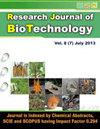Mutation breeding as a tool for improving plant characters: A review
IF 0.2
Q4 Biochemistry, Genetics and Molecular Biology
引用次数: 0
Abstract
Identifying plants with desirable traits among existing plant varieties is the initial and most important step in plant breeding. Plant breeding requires the genetic variation of useful traits for crop improvement or crop betterment. The plant breeding depends upon the genetic variation. In nature, variation occurs mainly as a result of mutation and without it, plant breeding would be impossible. Mutation as a mechanism of creating variability was identified by Hugo de Vries while experimenting on the rediscovery of Mendel’s Law of Inheritance.17 Mutation arises in two ways; First, spontaneous mutation which occurs without treatment of the organism with an exogenous mutagen and secondly induced mutation which occurs due to the treatment of a plant or plant parts such as seed, stem, cuttings, pollen and ovules with the help of mutagens. The purposeful employment of the induced mutation for crop improvement is known as mutation breeding. The mutation breeding is also known as the variation breeding.There are mainly two types of mutagens (agent to cause mutation) i.e. physical and chemical mutagens. The mutant shows higher potential for improving plant architecture leading to better crop improvement and used as complementary and rational tool in plant breeding. Mutation breeding programme should be clearly planned and should be large enough with sufficient facilities to screen large population in short time. This review highlights the role of mutation breeding in improvement of qualitative and quantitative characters of crop plant.诱变育种作为植物性状改良手段的研究进展
在现有植物品种中鉴定具有理想性状的植物是植物育种的第一步,也是最重要的一步。植物育种需要对作物改良或作物改良有用性状的遗传变异。植物育种取决于遗传变异。在自然界中,变异主要是突变的结果,没有突变,植物育种是不可能的。突变是一种创造变异的机制,是由雨果·德·弗里斯在重新发现孟德尔遗传定律的实验中发现的。17突变以两种方式产生;第一种是自发突变,这种突变是在没有外源诱变剂的情况下发生的;第二种是诱变突变,这种突变是由于在诱变剂的帮助下对植物或植物部分(如种子、茎、插枝、花粉和胚珠)进行处理而发生的。有目的地利用诱导突变进行作物改良称为突变育种。突变育种也被称为变异育种。诱变剂主要有两种,即物理诱变剂和化学诱变剂。该突变体具有较高的改良植株结构的潜力,可作为植物育种的互补和合理工具。突变育种计划应明确规划,规模应足够大,有足够的设施在短时间内筛选大量种群。本文综述了诱变育种在提高作物质量和数量性状方面的作用。
本文章由计算机程序翻译,如有差异,请以英文原文为准。
求助全文
约1分钟内获得全文
求助全文
来源期刊

Research Journal of Biotechnology
工程技术-生物工程与应用微生物
CiteScore
0.60
自引率
0.00%
发文量
192
审稿时长
1.5 months
期刊介绍:
We invite you to contribute Research Papers / Short Communications / Review Papers:
-In any field of Biotechnology, Biochemistry, Microbiology and Industrial Microbiology, Soil Technology, Agriculture Biotechnology.
-in any field related to Food Biotechnology, Nutrition Biotechnology, Genetic Engineering and Commercial Biotechnology.
-in any field of Biotechnology related to Drugs and Pharmaceutical products for human beings, animals and plants.
-in any field related to Environmental Biotechnolgy, Waste Treatment of Liquids, Soilds and Gases; Sustainability.
-in inter-realted field of Chemical Sciences, Biological Sciences, Environmental Sciences and Life Sciences.
-in any field related to Biotechnological Engineering, Industrial Biotechnology and Instrumentation.
-in any field related to Nano-technology.
-in any field related to Plant Biotechnology.
 求助内容:
求助内容: 应助结果提醒方式:
应助结果提醒方式:


